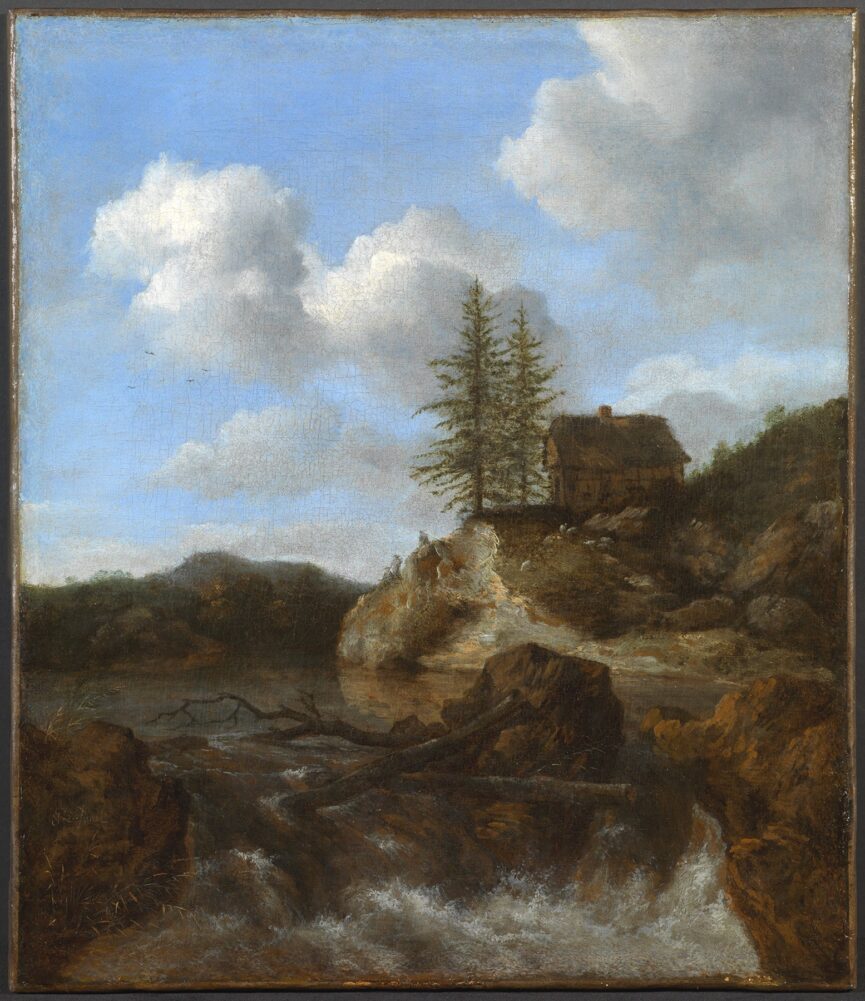Jacob van Ruisdael
Haarlem circa 1628 - Amsterdam 1682A Scandinavian Landscape with a cataract in the foreground and a cottage on a promontory beyond
Oil on canvas: 15 1/4 x 13 1/4 in. 38.75 x 33.75 cm. Signed lower left
Provenance: Christie's, July 1978, fully catalogued as 'Jacob van Ruisdael'
Mr.Frits Duparc , ex-curator of the Mauritshuis, The Hague, has kindly endorsed the authorship of Jacob van Ruisdael, and states that the signature appears to be authentic.
Jacob van Ruisdael was undoubtedly the great poet of the Dutch seventeenth century landscape and its most accomplished interpreter. His landscapes go beyond the celebration of Dutch scenery and touch a profound note that responds to Rembrandt’s searching portraiture.
After training in Haarlem under his father, also a landscape painter Isaac van Ruisdael, and his uncle, the renowned landscapist Salomon van Ruisdael, Jacob Isaackzoon, as he became known, focused on meticulously executed woodland scenes with dense foliage and in a limited format. In the early 1650’s he visited the south east of The Netherlands along the German border with his colleague Nicolaes Berchem, where he developed a more monumental style inspired by the great castle of Bentheim. Exaggerating its position crowning a modest hill, Ruisdael found a powerful new idiom with which to depict his favoured themes of forest glades, giant copses and even the soaring and emotionally charged cloudscapes, which were to have such a profound influence on Constable.
Ruisdael moved from Haarlem to Amsterdam around 1656, no doubt searching for a more commercial market. Our landscape belongs to a phase in the late 1650’s when Ruisdael fell under the influence of Allart van Everdingen, and produced a series of views of waterfalls and cataracts inspired by the older artist’s. Everdingen had in fact visited Norway so his works were based on first-hand experience of the scenery and the wood-logging trade that was practised there and which provided the economic link with The Netherlands, who imported the wood to build its navy. Although he never visited Norway, Ruisdael capitalised on this market and produced a series of highly commercial similar views, maybe less true to nature than Everdingen’s but characterised by more sure composition and stronger architectonic values. Stately fir trees, soaring promontories crowned by towers, and the numerous powerful rocks give such landscapes a strength that Everdingen’s lacked, although inevitably the detail is less naturalistic. Ruisdael’s works are also informed with the covert symbolism that underpins the Dutch seventeenth century conception of landscape. While celebrating the beauty of nature Ruisdael sends a subtle message through his selection of motifs intended to emphasise the beauty, and the transience, of divine creation. The rushing water can be seen as a metaphor for the rapid passing of time, ‘the rushing dale of existence and the need to wait patiently for the salvation of the Lord’. Houbraken, Ruisdael’s earliest biographer refers, in the artist’s depiction of the transistory, to ‘The wonderful transformations in created things.’ Understandably such pictures became Ruisdael’s most successful works and were prized even above the aerial views of Haarlem and the allusive Jewish Cemetery , perhaps answering to an early taste for the foreign and the exotic. Our view with its vertical format represents many of these characteristics, albeit it in a softer and less heroic idiom, and with a more serene atmosphere. The hallmark qualities in the present work are the diaphanous clouds and the exceptionally delicate and translucent treatment of the splashing water, again so clearly evoked by Houbraken: “He [Ruisdael] painted….foreign landscapes, particularly those in which water was to be seen falling from one rock to end noisily…tumbling down or spraying out. He could portray water splashing or foaming as it dashed on the surrounding rocks so naturally, tenderly and transparently, that it seems to be real water.”
Similar views of waterfalls from this period can be seen in the Herzog Anton-Ulrich Museum, Brunswick, and the Rijksmuseum, Amsterdam.

